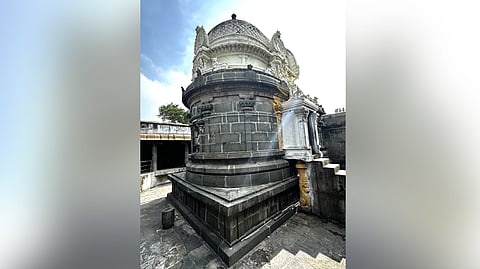

An ancient temple for god Siva, worshipped as Brahmapurishwara is situated in Perunagar, a village not too far from Kanchipuram in Thiruvannamalai District. According to the Sthala Puranam, god Brahma worshipped Siva here and hence this name. This history of this village goes back to at least the 12th century CE when the Cholas were ruling over vast areas of south India. This village has retained the name Perunagar without any change as seen from the Chola inscriptions which mention the name as Perunagar alias Nityavinodanallur. Incidentally, Nityavinoda was one of the titles of Rajaraja Chola I (985-1014 CE). The Siva Linga now worshipped as Brahmapurishwarar was once worshipped as Brahmishwaram Udaiyar, Brahmapurishwara Mahadeva and Brahmishwaram.
The entrance to this temple is via a tall gopuram on the south side leading to a spacious prakaram (enclosure) which has a sanctum for Chakkara Vinayaka facing the gopuram. To the right is the large temple-tank called Brahma Tirtham and next to it is a sanctum enshrining a Lingam called Ishta Siddhishwara. The dwajastambham, bali-pitham and Nandi-mandapam are in this prakaram, facing another gopuram which leads to the second prakaram. A mandapam here has a pierced stone windown through which one can see the main east-facing Siva Lingam.
Of immense interest and importance is this prakaram is an image of goddess Jyeshta Devi, who was worshipped ardently in times bygone to ward off evil. This deity, the elder sister of Goddess Lakshmi, arose from Kshirabdi or the Ocean of Milk as did Lakshmi. Her image here might perhaps indicate a pre-Chola antiquity for this temple. Even today, people come from afar to offer pray to Jyeshta Devi in the Perunagar temple. The sanctum for Parvati, worshipped here as Pattuvadanambikai is in the second prakaram. Also in worship are the stone and bronze images of the sixty-three Nayanmars in a row, Somaskanda and Nataraja. The main sanctum is an apsidal (gajaprishta) vimanam, so called as it is shaped like the rear (prishta) of an elephant (gaja). The inner-most prakaram runs around this shrine, the outer walls of which have, in the devakoshtas (niches), the images of Ganesha, Dakshinamurti, Vishnu, Brahma and Durga. Many inscriptions are etched on these walls too.
The earliest of these important epigraphs is datable to 1170 CE and belongs to the reign of Rajaraja II, which records the names of neaby villages like Ukkal and Magaral which also have historically important temples. It mentions the coin Gandagopalan pudu-madai which was currency then. Several other stone records of the reign of the same king mention that Perunagar, like the nearby ones was situated in the ancient territorial area called Magaral Nadu, in the larger sub-division known as Eyir-Kottam in Jayangonda Chola-mandalam. Inscriptions of the later Pallavas of the 13th century, Pandya kings of the same period and epigraphs of the reigns of many Vijayanagar Emperors like Harihara II, Virupaksha, Krishnadeva Raya, Achyuta Raya and Sadasiva Raya are also seen in this historical temple.
Know your city
Perunagar is about 20 km from Kanchipuram on the road to Vandavasi.
Chithra Madhavan
cityexpresschn@gmail.com
The writer is a historian who focuses on temple architecture